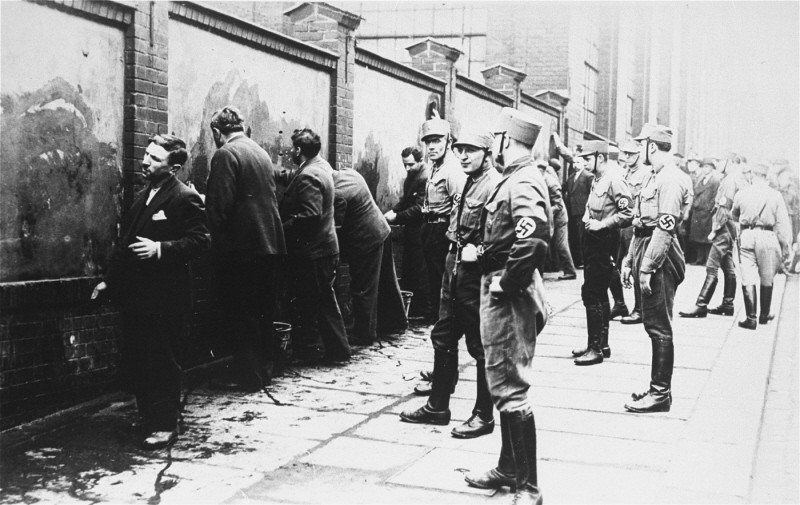
Nazi Terror Begins
After coming to power in 1933, the Nazis began turning Germany into a dictatorship. Police and Storm Troopers played a key role in stamping out opposition to Nazi rule.
After Adolf Hitler was appointed chancellor of Germany on January 30, 1933, he seized every opportunity to turn Germany into a one-party dictatorship. He also moved carefully to organize the police power necessary to enforce his long-term policies of "racial" purification and European conquest both inside and outside the legal framework of the German constitution.
Suspension of Individual Rights
On the night of February 27-28, 1933, a mentally disabled Dutch citizen set fire to the German parliament building (the Reichstag). Hitler and his propaganda minister, Joseph Goebbels, presented the incident as the prelude to an armed Communist uprising and persuaded the aging President Paul von Hindenburg to establish what became a permanent state of emergency. This decree, known as the Reichstag Fire Decree, suspended the provisions of the German constitution that protected basic individual rights, including freedom of the press, freedom of speech, and freedom of assembly.
The decree also permitted increased state and police intervention into private life, allowing officials to censor mail, listen in on phone conversations, and search private homes without a warrant or need to show reasonable cause. Under the state of emergency established by the decree, the Nazi regime could arrest and detain people without cause and without limits on the length of incarceration.
Intimidation
Hitler and the Nazi regime also resorted to simple and extra-legal terror to intimidate opponents. Nazi paramilitary formations, such as the Storm Detachments (Sturmabteilungen or SA, more commonly known as Storm Troopers) and the Protection Squads (Schutzstaffel or SS), had been established during the 1920s to terrorize political opponents and to protect Nazi leaders. After the Nazis came to power, many members of these units were recruited as auxiliary policemen. They were allowed to arbitrarily beat or kill persons they deemed to be opponents. In addition, Nazi Party faithful assaulted those they perceived to be enemies of the regime—in individual spontaneous acts of violence or in locally organized waves of persecution, .
The SS was a particularly important tool of Nazi terror. Its members would staff the concentration camps, in which perceived enemies of the regime were imprisoned.
Control of the Police
In addition, SS chief Heinrich Himmler also gained control over the regular (nonparty) police. Under Himmler and his deputy, Reinhard Heydrich, the SS centralized the German political police forces within a new agency, the Gestapo (Geheime Staatspolizei; Secret State Police). Together with a newly unified nationwide criminal police force, these plainclothes detectives used ruthless methods to identify and arrest political opponents and others who refused to conform to the policies of the Nazi regime.
Arrests of Political Opponents
In the months after Hitler took power, SA and Gestapo agents went from door to door looking for Hitler's enemies. They arrested Socialists, Communists, trade union leaders, and others who had spoken out against the Nazi Party; some were murdered. By the summer of 1933, the Nazi Party was the only legal political party in Germany. Nearly all organized opposition to the regime had been eliminated. Democracy was dead in Germany.
Denunciations of Fellow Citizens
Essential to the intimidating effects of the terror was the willingness of many German citizens (whether out of conviction, greed, envy, or vengeance) to denounce their fellow citizens, Jewish and non-Jewish, to the police. The Gestapo could not have exercised such control over German society without the benefit of this steady stream of denunciations, many of which were entirely unfounded.
Detention Sites and Camps
Many of the new Nazi authorities, including the SA, SS, and municipal administrative heads, established detention "camps" throughout Germany. In addition to actual camps, these detention facilities included old warehouses, abandoned factories, and other buildings. Here the Nazi authorities held political opponents without trial and under cruel and brutal conditions.
On March 20, 1933, the SS established a camp in an abandoned munitions factory outside Dachau, located near Munich in southwestern Germany. The Dachau concentration camp would become the "model" for a vast system of SS-managed camps.
Critical Thinking Questions
- How did the Nazi government justify the changes in policy and law from a democracy to one party dictatorship?
- How did the outside world react to these changes?
- What obligations, if any, do other governments and international organizations have when a government makes internal changes that are more repressive?